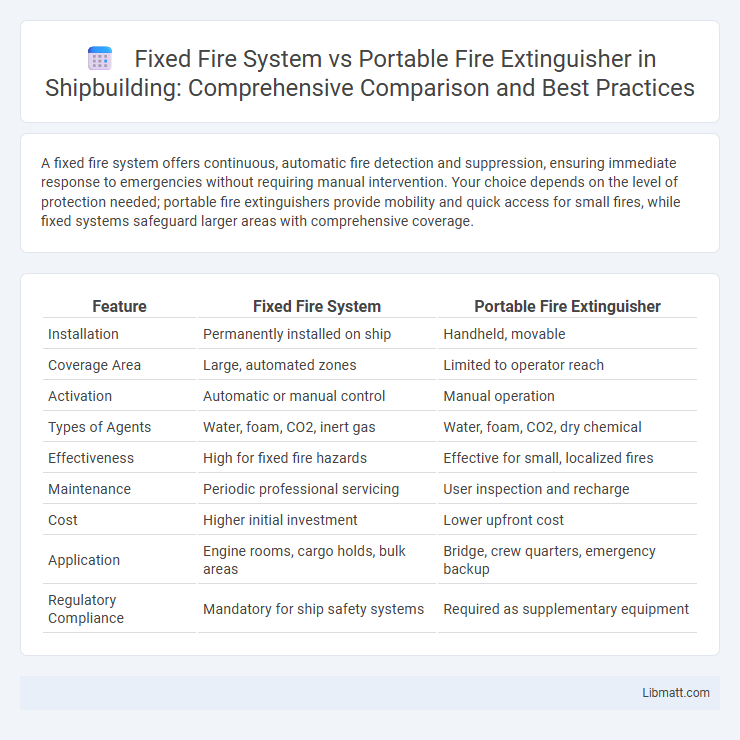A fixed fire system offers continuous, automatic fire detection and suppression, ensuring immediate response to emergencies without requiring manual intervention. Your choice depends on the level of protection needed; portable fire extinguishers provide mobility and quick access for small fires, while fixed systems safeguard larger areas with comprehensive coverage.
Table of Comparison
| Feature | Fixed Fire System | Portable Fire Extinguisher |
|---|---|---|
| Installation | Permanently installed on ship | Handheld, movable |
| Coverage Area | Large, automated zones | Limited to operator reach |
| Activation | Automatic or manual control | Manual operation |
| Types of Agents | Water, foam, CO2, inert gas | Water, foam, CO2, dry chemical |
| Effectiveness | High for fixed fire hazards | Effective for small, localized fires |
| Maintenance | Periodic professional servicing | User inspection and recharge |
| Cost | Higher initial investment | Lower upfront cost |
| Application | Engine rooms, cargo holds, bulk areas | Bridge, crew quarters, emergency backup |
| Regulatory Compliance | Mandatory for ship safety systems | Required as supplementary equipment |
Introduction to Fire Protection Systems
Fixed fire protection systems provide continuous, automated fire detection and suppression for larger or high-risk environments, ensuring rapid response through integrated components like sprinklers, alarms, and control panels. Portable fire extinguishers offer immediate, manual intervention suitable for small, localized fires, allowing occupants to control fire outbreaks before they escalate. Both systems play complementary roles in maintaining safety by addressing different fire scenarios with appropriate technology and accessibility.
What is a Fixed Fire System?
A Fixed Fire System is a permanent fire suppression setup designed to protect specific areas by automatically detecting and extinguishing fires using built-in piping and discharge nozzles. Unlike portable fire extinguishers, these systems are integrated into a building's infrastructure, providing continuous protection without manual operation. You benefit from immediate hazard response and reduced fire damage risk with a properly installed Fixed Fire System.
Understanding Portable Fire Extinguishers
Portable fire extinguishers are essential handheld devices designed for immediate response to small fires, offering mobility and quick access in various environments. Understanding the types, classifications, and proper usage of portable extinguishers ensures effective fire suppression tailored to specific fire classes like A, B, C, or K. Your familiarity with selecting and operating the correct portable fire extinguisher significantly reduces fire damage and enhances safety in emergency situations.
Key Components and Mechanisms
Fixed fire systems utilize integrated components such as detectors, control panels, and sprinkler heads designed for automatic fire detection and suppression throughout a building. Portable fire extinguishers rely on hand-held cylinders containing specific extinguishing agents like water, foam, CO2, or dry chemicals, activated manually via a valve and nozzle mechanism. Your choice between these systems should consider the scale of protection needed and the fire risk environment to ensure optimal safety.
Coverage and Effectiveness Comparison
Fixed fire systems provide comprehensive coverage by automatically detecting and suppressing fires across large areas, ensuring rapid response and minimizing damage. Portable fire extinguishers offer targeted, on-the-spot fire suppression but require immediate human intervention and are limited to small-scale incidents. Your choice depends on the specific environment and risk level, with fixed systems suited for continuous, wide-area protection and portable extinguishers best for quick, manual fire control.
Installation and Maintenance Requirements
Fixed fire systems require professional installation involving complex piping, sensors, and control panels, ensuring permanent fire suppression coverage tailored to specific building layouts. Portable fire extinguishers offer easy installation with minimal mounting hardware and can be relocated as needed, but demand regular inspections, pressure checks, and recharging to remain effective. Your choice depends on balancing the higher upfront installation and maintenance efforts of fixed systems against the flexibility and maintenance simplicity of portable extinguishers.
Cost Analysis: Fixed vs Portable
Fixed fire systems involve higher initial installation costs, including equipment, labor, and integration with building infrastructure, but offer long-term savings through automated detection and suppression capabilities. Portable fire extinguishers have lower upfront expenses, making them cost-effective for smaller spaces or targeted use, but require frequent maintenance and replacement, which accumulates over time. Your choice should weigh upfront budget constraints against ongoing operational costs and fire protection needs.
Application Suitability for Different Environments
Fixed fire systems offer continuous protection and are ideal for high-risk environments such as industrial facilities, large commercial buildings, and data centers where immediate fire suppression is critical. Portable fire extinguishers provide flexible fire-fighting capabilities and are suitable for small offices, residential buildings, and vehicles where mobility and quick access are essential. Selecting between fixed and portable systems depends on factors like fire risk level, space size, and the need for rapid or targeted fire control.
Regulatory Standards and Compliance
Fixed fire systems comply with rigorous regulatory standards such as NFPA 13 for sprinkler systems, ensuring continuous protection and automatic activation in commercial and industrial settings. Portable fire extinguishers must meet UL 299 and UL 711 standards for performance and safety, requiring routine inspections and maintenance according to OSHA and NFPA 10 regulations. Adherence to these compliance requirements guarantees the effectiveness and reliability of both fixed systems and portable extinguishers in fire safety protocols.
Choosing the Right Fire Protection Solution
Choosing the right fire protection solution depends on the specific risk, environment, and fire hazard level present. Fixed fire systems provide continuous, automated fire detection and suppression, ideal for large or high-risk areas such as industrial facilities or data centers. Portable fire extinguishers offer flexible, immediate response options suitable for smaller spaces or initial fire control, complementing fixed systems for comprehensive safety coverage.
Fixed fire system vs portable fire extinguisher Infographic

 libmatt.com
libmatt.com